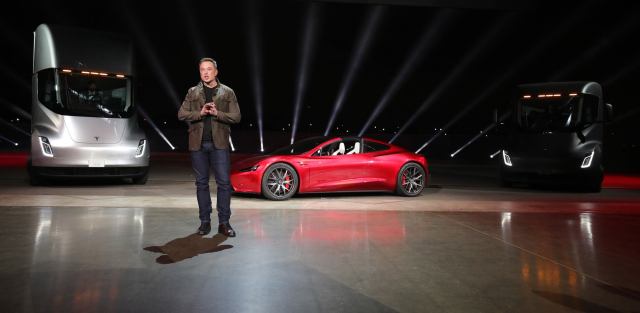Elon Musk, Chairman and CEO of Tesla, unveils the company’s new electric semi-truck in Hawthorne, California, on November 16, 2017. TESLA/UPI/PA Images

In UnHerd’s special series on the global oil industry, our writers anticipate a future in which the oil price falls to just $10 a barrel. As we admit, this runs counter to the likely price movements over the short term). It is also contrary to longer-term predictions that demand for oil will remain constant for decades to come.
For instance, OPEC doesn’t foresee a peak in oil demand before 2040. Such confidence may raise eyebrows – especially given the progress being made on electric cars. However, as Ross McCracken explains in a blogpost for Platts, the long range forecasts have factored that in:
“That oil demand from Light Duty Vehicles — everyday passenger cars — will contract is already assumed. This results only partially from the adoption of Electric Vehicles (EVs); another factor is the improving fuel efficiency of internal combustion engines, which is expected to increase on average for the global parc (population of cars) from about 25 mpg today to 40 mpg by 2040.
“Thus the number of cars in the world can nearly double, but so long as even a fairly small proportion of them are New Energy Vehicles, overall oil demand from the sector will fall.”
But what the forecasters haven’t factored in is the electrification of Heavy Duty Vehicles (HDVs) – i.e. trucks and buses – which account for a bigger share of global oil demand than cars do.
The electrification of buses is already underway:
“Production of e-buses has been ramped up surprisingly quickly in China, in good part supported by subsidy, but they have found both a ready domestic and foreign market in megacities as far afield as Buenos Aires and London, where politicians are keen to cut urban air pollution. Although figures vary, Chinese e-HDV production, largely of buses, exceeded 100,000 in 2016, up from less than 10,000 a few years earlier.”
The electrification of trucks, however, is a more difficult challenge. Commercial freight carriers are less likely to receive government subsidies than public transport; and because they mostly travel between cities, rather than within them, there’s less (though growing) pressure to curb the local pollution they produce. Furthermore, the long journeys they undertake and the heavy loads they carry push up against the limitations of battery technology.
The assumption, therefore, is that diesel-guzzling trucks will be around for decades, propping-up global oil demand for the foreseeable future:
“Global GDP is forecast to nearly double between now and 2040 and that means much more commerce, people and trade, adding hugely to the movement of goods and people around the planet. So if commercial transportation cannot be electrified, then oil demand retains a huge market sufficiently robust to deliver long-term growth over and above the expected contraction in the LDV segment.”
Of course, all of that is to reckon without faster-than-expected innovation. And, as if by magic, Tesla has just unveiled a new fully-electric semi-automated truck – yours for a mere $150,000 (for a 300-mile range vehicle) or $180,000 for one that can do 500-miles before recharging. Production is due to start in 2019, disrupting the HDV market much earlier than had been commonly expected.
The availability of a workable alternative to diesel could also accelerate the pace at which governments crackdown on air pollution in residential areas, with tougher regulation and higher levies on dirty vehicles further tipping the economics in favour of e-trucks.
This, Ross McCracken argues, could be a very big deal:
“If commercial transportation can adopt electrification, it would result oil demand peaking much earlier than most forecasts currently suggest and oil would become a sunset industry.”
People are reluctant to invest in sunset industries – especially when the investments required tie-up capital for decades. Without the funding to modernise ancient infrastructure, the pace of decline accelerates. Therefore thanks to innovation and capitalism at its dynamic, disruptive best, the end of oil as a major industry could come a lot faster than conventional forecasters anticipate.
This is something that worth bearing in mind more generally: Mere assumption – no matter how expertly arrived at – is always vulnerable to those who imagine the impossible and make it happen.










Join the discussion
Join like minded readers that support our journalism by becoming a paid subscriber
To join the discussion in the comments, become a paid subscriber.
Join like minded readers that support our journalism, read unlimited articles and enjoy other subscriber-only benefits.
Subscribe